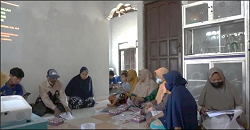Edukasi Budidaya Edamame Organik di Kelurahan Cempaka, Kota Banjarbaru dalam Mendukung Sistem Pertanian Berkelanjutan Education on Organic Edamame Cultivation in Cempaka Village, Banjarbaru City in Encouraging Sustainable Agriculture Systems
Main Article Content
Abstract
Edamame, as an essential food ingredient, has the potential to be developed with a high level of market demand every year. The ability of edamame cultivated on all types of soil has the opportunity to be introduced to the residents of Cempaka Village, Banjarbaru. The introduction of integrated pest control-based cultivation and land management using compost media from agricultural waste by considering environmental sustainability needs to be conveyed and later applied to build environmentally friendly sustainable agrarian concepts. The purpose of this Community Service Activity is to educate and train the skills of the people of Cempaka Village, Banjarbaru City, regarding organic edamame cultivation to improve the quality of edamame cultivation and production sustainably. The method used in this activity is a classical approach in the form of lectures and distributing knowledge questionnaires before and after the extension material. The results of the pre-activity questionnaire showed that 65% of participants only knew about edamame, compost, and organic fertilizers but not about integrated pest control techniques. After the activity, participants' knowledge increased by approximately 100%, hoping that the Cempaka Village community could apply it in the field.
Downloads
Article Details

This work is licensed under a Creative Commons Attribution-ShareAlike 4.0 International License.
Authors who publish with this journal agree to the following terms:
- Any article on the copyright is retained by the author(s).
- Author grant the journal, right of first publication with the work simultaneously licensed under a Creative Commons Attribution License that allows others to share work with acknowledgment of the work authors and initial publications in this journal.
- Authors are able to enter into a separate, additional contractual arrangements for non-exclusive distribution of published articles of work (eg, post-institutional repository) or publish it in a book, with acknowledgment of its initial publication in this journal.
- Authors are permitted and encouraged to post their work online (e.g., in institutional repositories or on their websites) prior to and during the submission process, as can lead to productive exchanges, as well as earlier and greater citation of published work.
- The article and any associated published material is distributed under the Creative Commons Attribution-ShareAlike 4.0 International License
References
Hakim, N.A. 2013. Perbedaan Kualitas dan Pertumbuhan Benih Edamame Varietas Ryoko yang Diproduksi di Ketinggian Tempat yang Berbeda di Lampung. Jurnal Penelitian Pertanian Terapan. 13(1):8-12. https://doi.org/10.25181/jppt.v13i1.163
Mayrowani, H. 2012. Pengembangan Pertanian Organik Di Indonesia. Forum Penelitian Agro Ekonomi. 30(2):91-108. http://dx.doi.org/10.21082/fae.v30n2.2012.9 1-108
Pratama, I.R., Jumar, J., Wahdah, R. 2019. Pengaruh Pupuk Kotoran Jangkrik terhadap Pertumbuhan dan Hasil Tanaman Edamame (Glycine max (L.) Merill. Agroekotek View. 2(2):67-73. https://doi.org/10.20527/agtview.v2i2.1107
Sahputra N., Yulia, A.E., Silvina, F. 2016. Pemberian Kompos Tandan Kosong Kelapa Sawit Dan Jarak Tanam Pada Kedelai Edamame (Glycine max (L) Merril). Jurnal Online Mahasiswa Fakultas Pertanian Universitas Riau. 3(1):1-12.
Setiawati, M.R., Sofyan, E.T., Nurbaity, A., Suryatmana, P., Marihot, G.P. 2017. Pengaruh Aplikasi Pupuk Hayati, Vermikompos dan Pupuk Anorganik terhadap Kandungan N, Populasi Azotobacter sp. dan Hasil Kedelai Edamame Glycine max L.) Merill pada Inceptisols Jatinangor. Agrologia. 6(1):1-10.
Soverda, N., Evita, Megawati, M. 2021. Pengaruh Clibadium Surinamense dan Rhizobium terhadap Pertumbuhan dan Produksi Kedelai Edamame. Jurnal Ilmiah Ilmu Terapan Universitas Jambi. 5(2):180-192.
Wibowo Y., Amilia, W., Karismasari, D.R. 2020. Manajemen Risiko Kehilangan Panen Edamame (Glycine max (L) Merr.) di PT. Mitratani Dua Tujuh, Jember. Jurnal Agroteknologi. 14(2):165-178. https://doi.org/10.19184/j-agt.v14i02.21448
Wihardjaka, A. 2018. Penerapan Model Pertanian Ramah Lingkungan sebagai Jaminan Perbaikan Kuantitas dan Kualitas Hasil Tanaman Pangan. Jurnal Pangan. 27(2):1-10. https://doi.org/10.33964/jp.v27i2.376
Winangun, Y.W. 2005. Membangun Karakter Petani Organik Sukses dalam Era Globalisasi. Yogyakarta: Kanisius.
Zahrah, S. 2011. Aplikasi Pupuk Bokashi dan NPK Organik Pada Tanah Ultisol Untuk Tanaman Padi Sawah Dengan Sistem SRI (System of Rice Intensification). Jurnal Ilmu Lingkungan. 5(2):114-129. http://dx.doi.org/10.31258/jil.5.2.p.114-129
